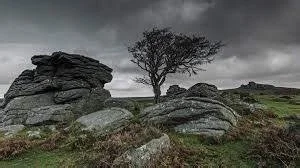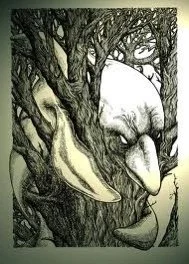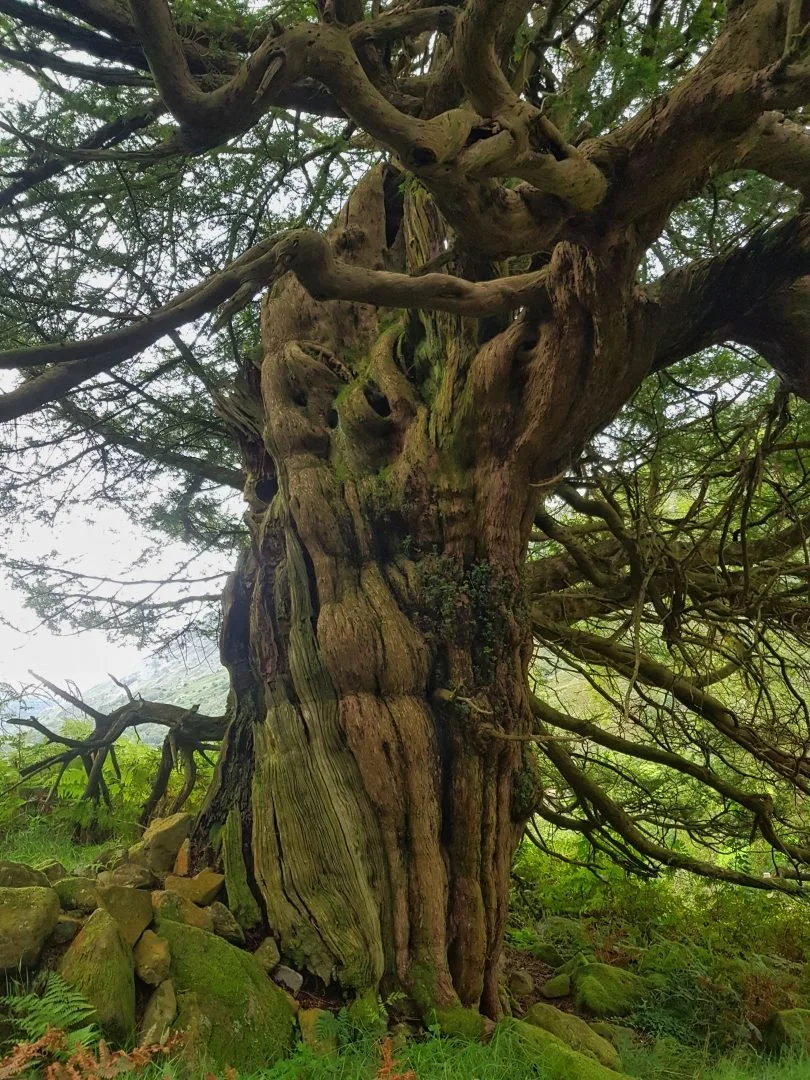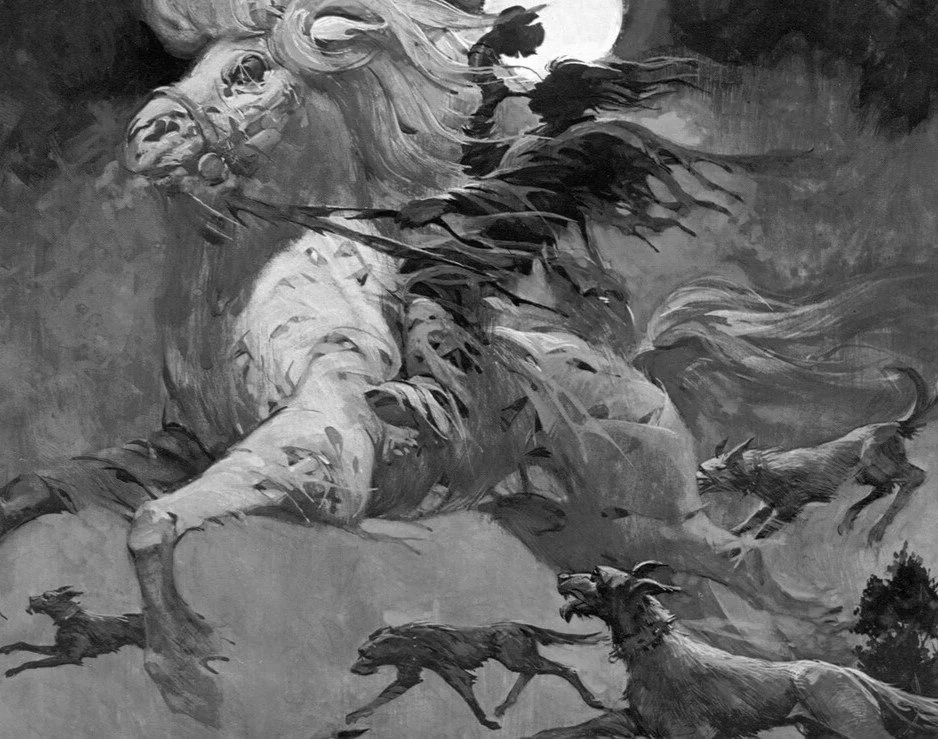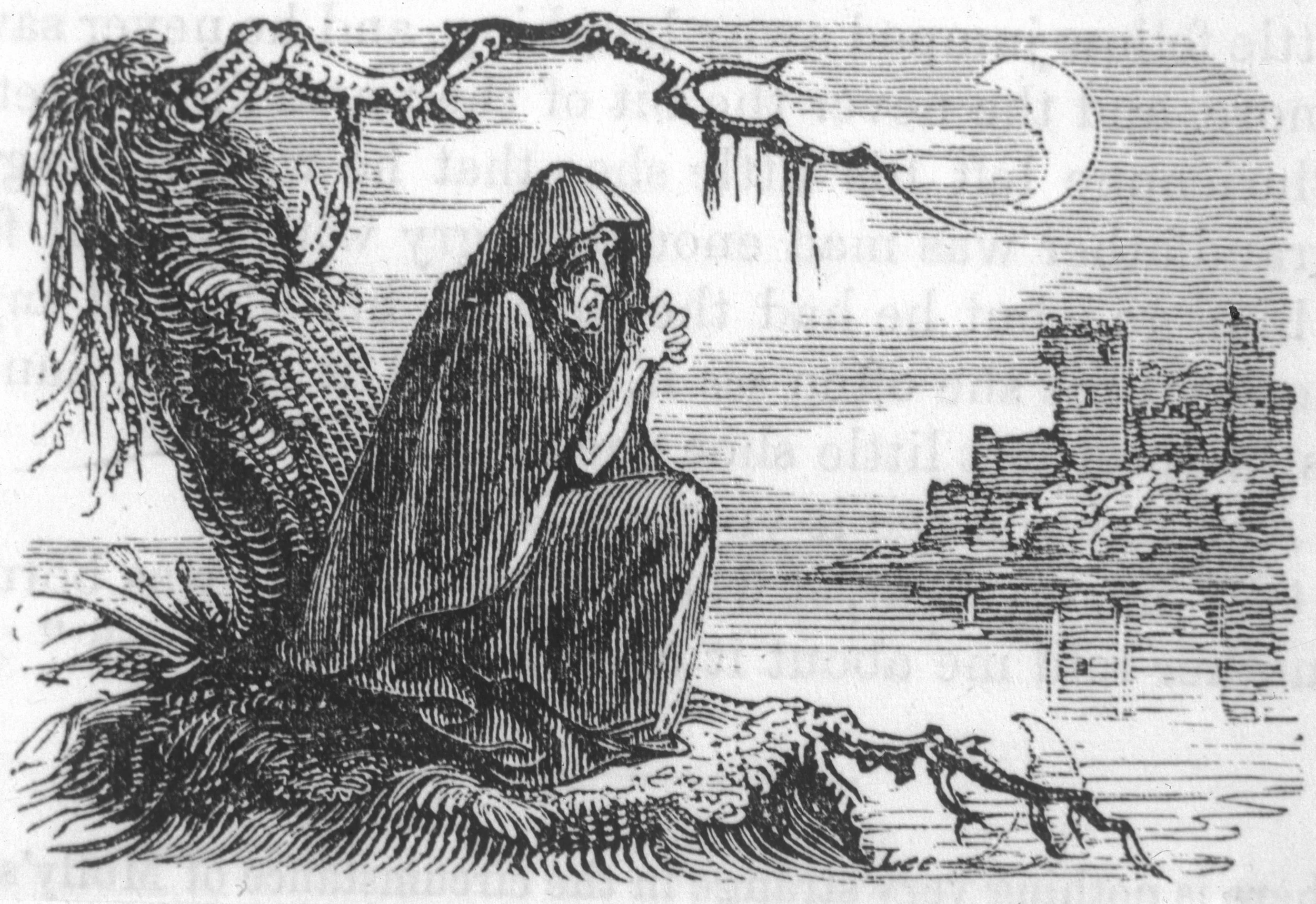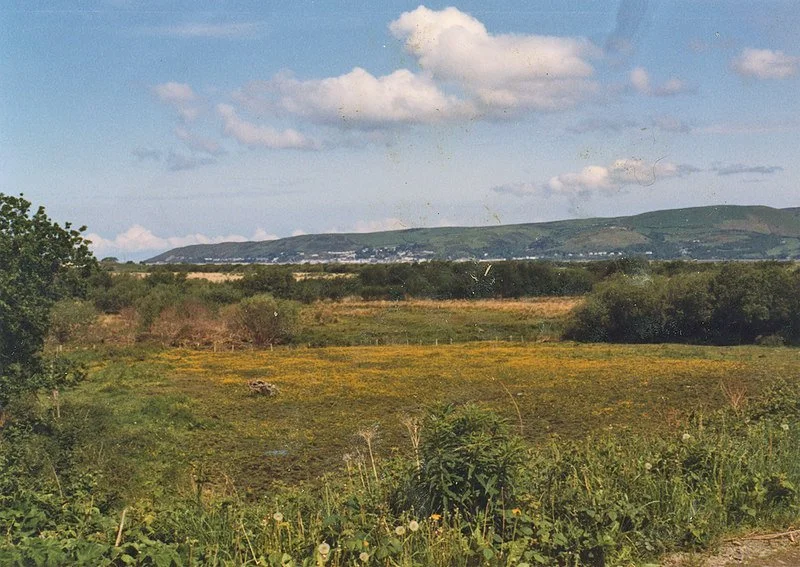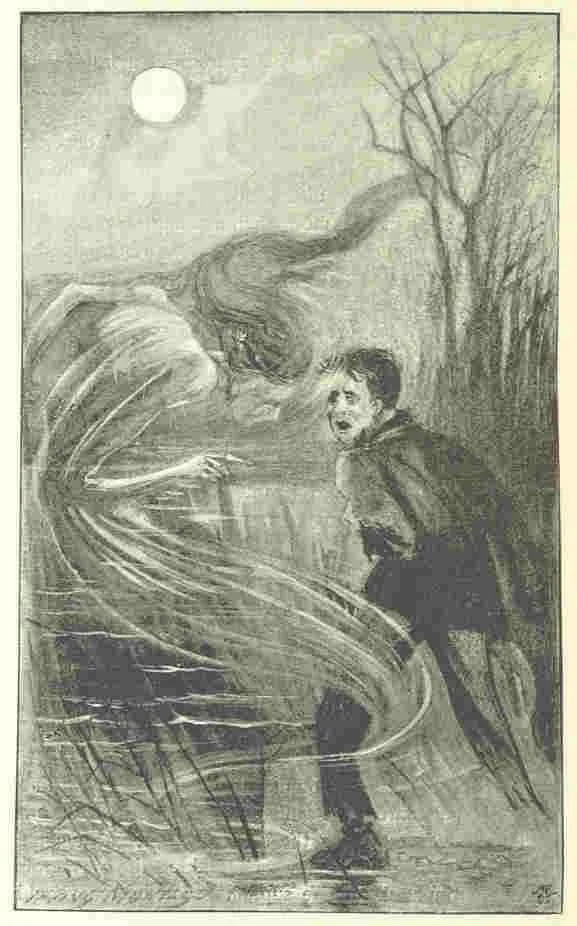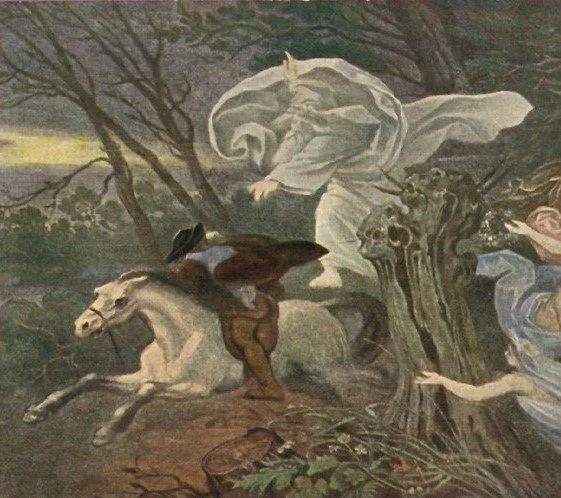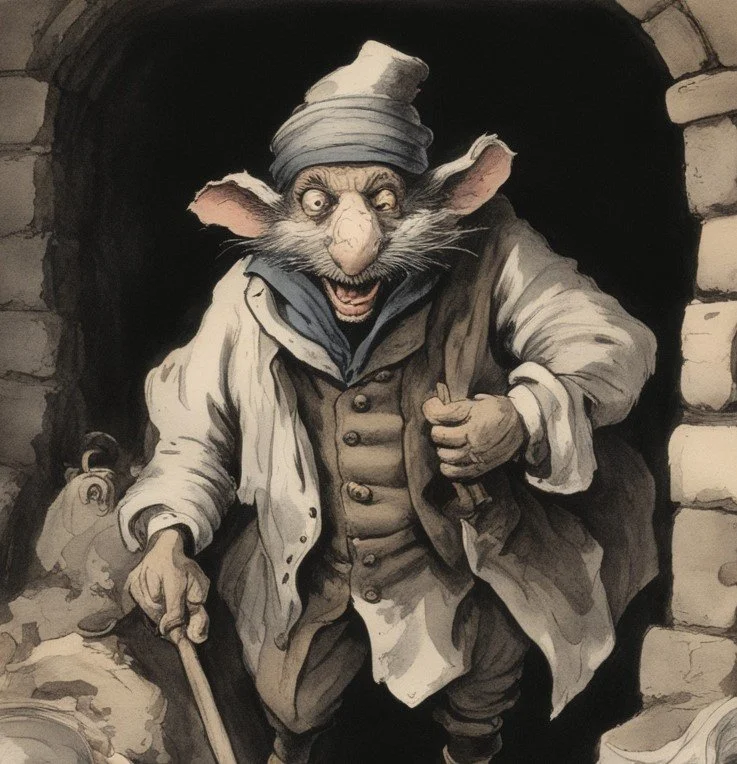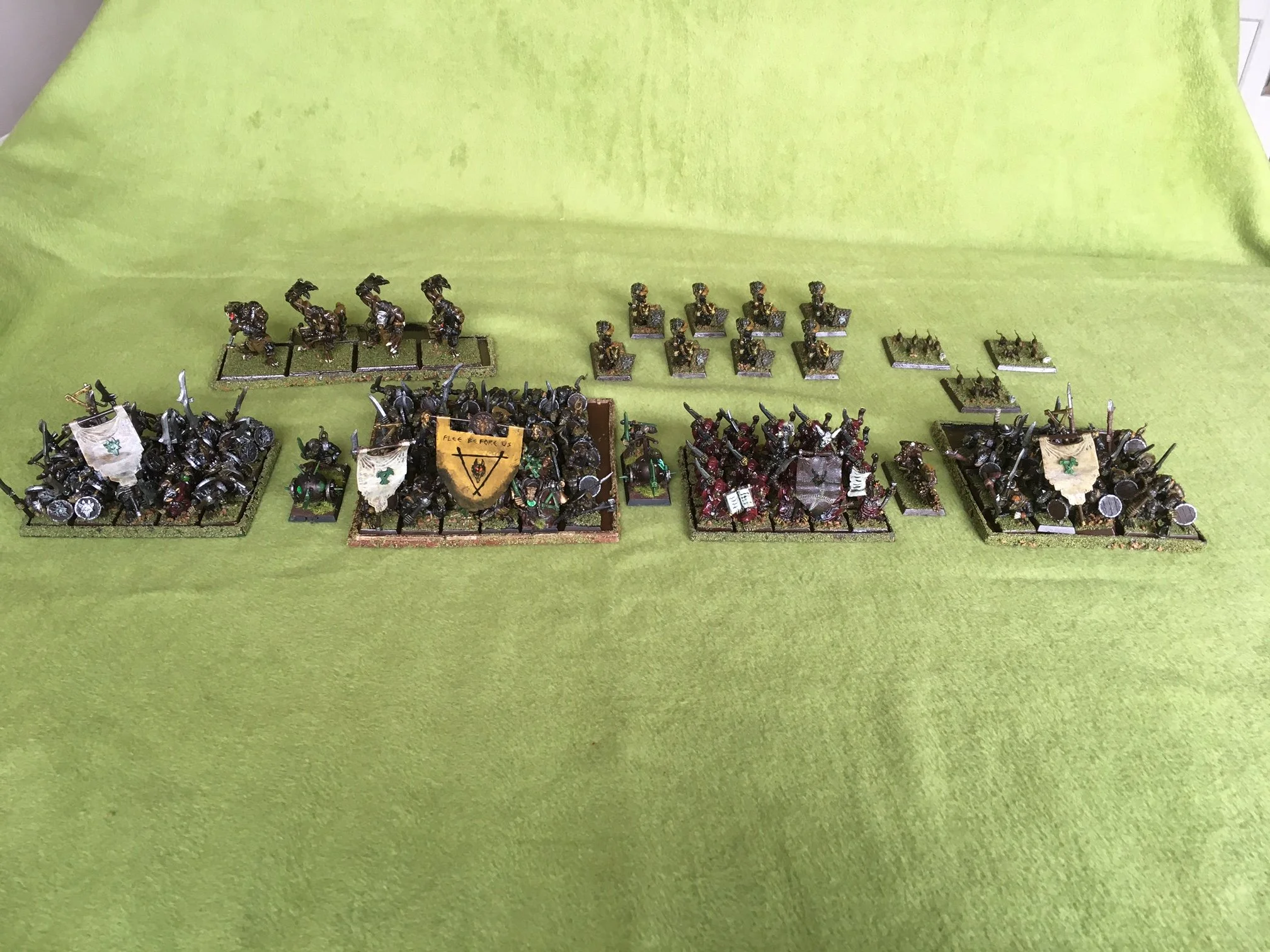The DeGribblification of Fireside Horror
The Gribblies emerge from dining on some poor unsuspecting traveller, to discover they have been evicted... (they don't really resemble what I describe in the story, but this is the best picture I could come up with)
I have recently had the good fortune to work with horror writer Carson Buckingham (currently nominated for The Face of Horror Award) who kindly acted as an editor on ‘Fireside Horror.’ This editing process resulted in a few changes in the book, nothing major, but interesting changes never-the-less.
Firstly she felt the short story ‘Fireside Horror’ need tying in to the overall book more, the villain of the book does appear in this story but it is quite subtle, so I added Elspeth to the tale to link it more clearly with the rest of the book.
Secondly, it was felt that in ‘The Witchbrands of Wendlelow,’ the encounter between Dafyd Ellis and the three guardians should be explored in more detail, so it has been.
Perhaps the biggest, and saddest change is the removal of the story ‘The Gribblies.’ It’s a tale I love and one written with my Dad in mind. But I have long suspected it has no place in ‘Fireside Horror.’ It is neither part of Elspeth and Nolan’s story, or Crom Cruach’s Tale. It was there because I loved it, but it stuck out like a sore thumb. So it has gone.
The result of removing the story from the book is a reduction in production costs, and this I have passed on to the reader, the book is roughly about £1 cheaper to buy now. The Audio book had already gone into production when these edits were made and the Narrator ‘Aubrey Parsons’ has done a wonderful job bringing the stories and characters to life, as such ‘The Gribblies.’ will still appear in the audio book as a bonus story.
I am horribly aware that new readers will be missing out on this chilling little tale, and so I intend to include it on my website, where it can be enjoyed by everyone for free. I just have to put on my tech head and figure out the best way to do it. Hopefully it will be sometime this month. Eventually it will feature in a collection of Wendllow short stories that are already written and should be released next year.
Finally a special thanks to Carson for all her hard work and I enclose a link to her book below, be sure to pick up a copy for the spooky season.
Ghostly Folklore for Halloween - The Okehampton Ghost Coach
Lady Howard in her ghostly coach.
The month is October, officially the spookiest month of the year, the nights are drawing in and Halloween is approaching. It is the time for Pumpkin Spice lattes, Russet leaves and mists and mellow fruitfulness. It is also a time for ghost stories. And so, each week this month I will talk about a different ghostly folktale. I will begin this creepy journey with The Okehampton Ghost Coach.
Okehmpton is a town on the northern edge of Dartmoor, in the English county of Devon. Now Dartmoor is atmospheric place, simply dripping with strange old tales, it was also the setting of Sir Arthur Conan Doyle’s famous story ‘The Hound of the Baskervilles. Okehampton is a charming town and well worth a visit, nearby are the Ruins of Okehampton Castle.
The little town has an unusual ghost, that of Lady Howard, who is said to travel each night from her old family home, Fitzford House, to Okehampton castle, in a spectral coach made from the bones of her four dead husbands!
Its is a tale that has been told around winter fires in Devon for centuries. There really was a Lady Howard, she lived in the 17th century and was the daughter of John Fitz, who owned, Fitzford House, near Tavistock. He had a reputation as a bit of a bad’un. Eventually it is said he went insane and committed suicide. The Family fortune was left to his daughter Mary.
Mary managed to outlive all four of her husbands and sadly also her son. After her death she acquired a poor reputation that earned her the name ‘The Wicked Lady.’ Some what unfairly as at no time during her life was she considered wicked.
As punishment for her supposedly terrible deeds it is said that Lady Howard must nightly ride from Fitzford House to Okehampton castle, there pluck a single blade of grass from the mound and return again to Fitzford House. When all the grass is plucked from the mound her punishment will be over.
Those unlucky few who have seen her ghostly coach when walking the roads around Okehampton on dark evenings, report the sound of rattling bones as it approaches, when the coach finally appear it is pulled by four headless horses and driven by a headless rider. Each corner of the coach is adorned with the skull of one of her husbands, it is just possible to see the pale, eyeless face of Lady Howard peering from out the window. Close by the coach runs a black dog with flaming eyes.
There are an unusual amount of hauntings in the counties of Devon and neighbouring Cornwall. Various reasons have been given for this, I list some below:
The rock beneath these counties is of a kind that can trap spiritual energies which become active under the right conditions, i.e. wet and stormy.
Smuggling was rife in these areas and the scary stories were created by criminal gangs to keep people off the roads at night-so they could move their contraband undisturbed.
The unusually strong scrumpy cider brewed in this part of the country.
So there we have the tale of Lady Howard and her phantom coach. The story was also immortalised in a song collected by Reverand Sabine Baring-Gould in 1891, given below. I also provide a link to the song as performed by the band ‘Secret Sky.’
My ladye hath a sable coach,
And horses two and four;
My ladye hath a black blood-hound
That runneth on before.
My ladye’s coach hath nodding plumes,
The driver hath no head;
My ladye is an ashen white,
As one that long is dead.
“Now pray step in!” my ladye saith,
“Now pray step in and ride.”
I thank thee, I had rather walk
Than gather to thy side.
The wheels go round without a sound,
Or tramp or turn of wheels;
As cloud at night, in pale moonlight,
Along the carriage steals.
“Now pray step in!” my ladye saith,
“Now prithee come to me.”
She takes the baby from the crib,
She sits it on her knee.
“Now pray step in!” my ladye saith,
“Now pray step in and ride.”
Then deadly pale, in waving veil,
She takes to her the bride.
“Now pray step in!” my ladye saith,
“There’s room I wot for you.”
She wav’d her hand, the coach did stand,
The Squire within she drew.
“Now pray step in!” my ladye saith,
“Why shouldst thou trudge afoot?”
She took the gaffer in by her,
His crutches in the boot.
I’d rather walk a hundred miles,
And run by night and day,
Than have that carriage halt for me
And hear my ladye say-
“Now pray step in, and make no din,
Step in with me to ride ;
There’s room, I trow, by me for you,
And all the world beside.”
The Sussex Knucker
The Knucker of Lyminster.
In the south of England lies Sussex. The name Sussex comes from the Old English Sūþsēaxe; lit. ‘South Saxons.’ It was once the Kingdom of Sussex, eventually becoming a county. It is an area containing many legends and lore, but today we will focus on the tale of the Knucker.
The name Knucker seems to have a few possible origins, one source could be the old Norse word Nikyr, which meant water monster. Another possible origin for the word is ‘Old Nick.’ slang for the devil.
There are a few different locations around Sussex where the Knucker could be located, and all the locations shared a similar feature, the presence of a ‘Knucker Hole.’ These were deep pools of water, said to be the home of the beastie, and also said to be bottomless. But what on earth is a Knucker? What did it look like? And what on earth did it get up to?
The Knucker was a water dragon, it was said to resemble a great sea serpent with wings and a blood chilling hiss. Unlike other dragons he was less interested in collecting hoards of gold and hassling Hobbits and Dwarves, and much more interested in devouring maidens (poor maidens, they always seem to get the worse end of the stick.)
Perhaps the best known Knucker lived in a Knucker hole close to the village of Lyminster. There are a few variations on his tale but an atypical version ran something like this:
Near the village of Lyminster there was a Knucker Hole said to be bottomless, and home to a dragon, the monster had terrorised the area for years and had devoured all the maidens, leaving only the Kings daughter. In desperation the King offer her hand in marriage to the person who could slay the beast. A local lad called ‘Jim Puttock’ fed The Knucker a giant poisoned pie, so large it had to be bought to the Knucker’s Hole by a horse and cart. The Dragon did not just eat the pie but devoured the horse and cart too (Now that is just greedy and unnecessary, poor horse.) Shortly afterwards it died of the effects of the poison. Unfortunately our young medieval pest controller never got to claim the King’s daughter’s hand, he himself accidentally ingested some of the poison in the pie and died the next day.
In another version of the tale it is a young knight who tries for the hand of the Princess, with similar results.
I hope you enjoyed this little foray into Dragonlore, next month is Halloween (the spooky season) and each week I will focus my blog on a different chilling tale, finishing with a very scary piece of folkore for Halloween.
Britains Weirdest Monster - The Highclere Grampus
The Highclere Grampus - in its Yew Tree home.
Highclere is a village located in England, in the northern area of the district of Hampshire. The village sits in the Wessex downs, an area of natural outstanding beauty, now there does seem to be something about monsters living in areas of natural beauty, but I suppose if I were a monster I would like to live somewhere nice too.
Highclere is perhaps most famous for Highclere Castle, the estate that was used as the location for Televisions ‘Downton Abbey.’ But Highclere also has the dubious honour of being home to one of the strangest monsters on this ancient Isle, ‘The High Clere Grampus.’
The Highclere Grampus (Not to be confused with Krampus, an Alpine Christmas Devil), made its home in an old Yew tree, in a churchyard, in the Highclere Estate Chapel. Now a Grampus is an old name for an Orca or Killer Whale, but is seldom used in this day and age.
Some people believe this tale dates back to around 1700s, maybe even before. The Highclere Grampus was said to resemble a Porpoise or maybe even a Dolphin, quite why such a creature would make a home in an Old Yew Tree is beyond me, I would have thought a lake would have been a better choice.
It was said that if locals were foolish enough to wander to close to the beasts arboreal home it would make disturbing grunting noises, causing them to flee in terror. Worse still, it was known to chase after young women, how it did this is not clear, I can only imagine it dragged itself along by its pectoral fins. Though quite how it managed to climb in and out of its Yew tree home is beyond my imagination. To be fair to this beastie there are no stories of it actually hurting anyone.
Naturally this made attending chapel on a Sunday a nightmare, girls being chased about, everyone else fleeing in terror from the beasts hideous noises. Total chaos.
The poor locals came to believed it was a denizen of Hell, sent by Old Nick himself to trouble them. They decided to approach the local Priest and asked him to deal with the problem. He agreed, and performed an exorcism. To everyone’s great relief it was banished to the Red Sea, some say for one hundred years, some say for a thousand. I personally believe it was a thousand, or else it would be back by now, terrifying modern day residents of the village.
If you enjoyed this little bit of obscure folklore, you may very well enjoy my book ‘Fireside Horror.’ It’s full of terrifying monsters, demons, cults, mysteries and ghosts. It is availsble from Waterstones online, and Amazon in the U.K. and U.S.A. Links below:
The Horror of the Hounds of Annwn
The Wild Hunt-featuring the Cŵn Annwn (Definitely not dogs you want to pet.)
In Welsh folklore, Annwn is the other world, it’s ruler is Arawn. In its earliest form it was a place of wonder, providing an afterlife of eternal youth with plenty of food and wine thrown in for good measure. But in the medieval period it started to feature in Arthurian legends, and its ruler was changed to Gwyn ap Nudd. He was a hunter and a Psychopomp-a Psycopomp is an entity that escorts or drives spirits to the afterlife.
And this is where things took a darker turn.
The first written mention of Arawn and Annwn is in The Mabinogion-an early book about Welsh mythology-in this he is portrayed in a positive way, befriending the Welsh hero Pwyll. Later with the arrival Christianity, Arawn became Nudd and took on a darker role, and Annwn, far from being a land of plenty, became Hell…
Christian tradition has Nudd being banished to Glastonbury Tor by Saint Collen, for various misdeeds. It is now that he he becomes The Wild Hunter, leading the Cŵn Annwn, hounds of Annwn-singular Ci Annwn. Christians dubbed these creatures the Hounds of Hell, believing they were owned by Satan.
The Cŵn Annwn, are said to be most active in the autumn and winter-time, the sound of their mournful baying on the cold wind was said to be an omen of death. They favourite prey was believed to be wrong doers, who they would chase down remorselessly. According to myth, the louder their growling the further away they are said to be, when they are close at hand their barking is faint, so it is then you really have to worry.
Being a hunting hound a Ci Annwn was a fairly decent sized pup. They are often portrayed as being a spectral white colour, with distinct red ears, the Celts associated the colour red with death. Some have suggested that the sound of migrating geese may have inspired legends of the Cwm Annwn. Others think that Nudd may be a Welsh personification of winter.
If you enjoy folklore and stories of the supernatural, why not try my book ‘Fireside Horror.’ It features boggarts, ghosts, prehistoric demons and cults, all inspired by folklore. It is available from Amazon and Waterstones online, links below.
The Skeletal Scarecrow of the Cotswolds
The Skeletal Scarecrow
The Area known as the Cotswolds contains many Legends and superstitions, but today I will focus primarily on the little known tale of the Skeletal Scarecrow said to haunt a field outside a idyllic little village called Broadway.
The Cotswolds is a region that can be found in the southwest of England, it is largely rural with a few pretty villages and towns dotted around. Most of the houses are made from the famous local, golden-coloured Cotswold Stone. It has been designated an ‘Area of Outstanding Natural Beauty,’ and if you ever get a chance to visit, and see the rolling hills and meandering rivers you will understand why.
Ephraim Rolfe was a simple-minded young boy, he worked as a ‘Bird Scarer.’ Bird Scarers where like human scarecrows, the job involved standing in a field often with a device called a clapper which they used to frighten away birds so they did not eat all the crops and seed. The job was usually given to young boys, (in my day youngsters got a paper round) who would be out from dawn till dusk whatever the weather, spooking the local fowl. by all accounts the pay was meager (so in that sense very similar to a paper round.)
Ephraim Rolfe may have a been a simple youngster, but he was well loved in Broadway village for his kindness to youngsters and his affinity to animals. At dusk one evening the local squire was out patrolling his land looking for hated poachers, he saw a suspicious figure lingering in one of his fields, and being a man of action he took the decision to shoot first, ask questions later. Sadly the person he shot was not a poacher, as you have probably guessed it was young Ephraim Rolfe, about his business scaring the local wildlife. It begs the question how was stupid was the squire? It was his field, and he had hired Ephrim to scare in it, so why shoot…. (sigh) never mind.
Ever since then villagers walking past that field on wild nights, when the moon emits its spectral glow through the clouds, have claimed to see the ghost of young Ephraim - a skeletal scarecrow, standing a silent lonely vigil. Legend does not identify exactly which field this phantom guards, but it is said to be next to the road leading towards Evesham. So if you feel brave enough and you find yourself in Broadway, and at lose end, why not have a evenings ramble over the fields, who knows what you may encounter.
If you enjoy folklore, ghost stories, and tales of weird monsters why not check out my book ‘Fireside Horror.’ Link below -
Yr Hen Wrach - The Crone of the Bog.
Yr Hen Wrach - The Crone
Yr Hen Wrach (roughly pronounced - Err Hen rack) is a being from Welsh folklore, her name means means Crone. She was an elderly lady, now elderly ladies in folklore get a lot of bad press, usually they are portrayed as witches or Hags (a bit harsh, believe it or not my Nan is an elderly lady and she is lovely, more than willing to share her last Hobnob Biscuit with anyone.) But I digress, Yr Hen Wrach was most certainly not an old charmer. She lived in a place called Cors Fochno (Borth Bog), one of the largest unspoilt, raised mires in Britain. The Village of Borth lay nearby.
Yr Hen Wrach was a terrible Hag-like being, believed to stand nearly seven feet tall, and terrifying to behold. She haunted the treacherous wastes, appearing from the mist shrouded bogs to lure unwary travellers to their doom, definitely not the sort of person to share her last Hobnob.
When she was in a particularly bad mood, and when the mist spread from the marshland to envelope the village of Borth she would rise from the peaty depths to wander amongst the cottages, should she discover any unfortunate person out and about, she would breath on them, this would cause the poor soul to sicken, and in some cases even die! Naturally when the people of Borth saw the mists drifting in from the mire they would lock their doors and shutter their windows.
Borth Bog holds many other tales, it is believed to be the home of a Toad, said to be the second oldest creature on Earth. Alien Big cats are regulalry seen by local folk, there is also a submerged forest which can be seen at nearby Borth bay, with tree stumps dating back to 1500BC. It is said the ancient stumps are all that remain of the lost Kingdom of Cantre’r Gwaelod, a fertile land that was drowned beneath Cardigan Bay.
I hope you enjoyed this little exploration of Welsh Folklore. If you did you may like my book ‘Fireside Horror.’ The links are below, if you feel brave enough to purchase a copy.
#Folklore #Folkhorror #paulsheldon #Horror #welshmythology #welshlegends #horror #book #horrorbook #folkhorrorbook #myths #legends
The Curse of Tiddy Mun
A picture of the Tiddy Mun (though personally I think he looks a little on the tall side, and seems to lack a beard.)
The Tiddy Mun is a character from Lincolnshire Folklore. For those outside the United Kingdom, Lincolnshire is a county in the East Midlands, it is a relatively rural area made up of rivers, fens and rolling countryside.
Years ago Lincolnshire had a lot more wetland, but it was decided that this should be drained and turned into fields for farming. This is where The Tiddy Mun comes in. The Tiddy Mun meaning ‘The Small Man’ in the local dialect, was a sort of gnome-like entity with white hair and a long white beard that would have put Gandalf to shame. He was described as being three to four spans high (A span is the distance measured by a human hand, from the tip of the thumb to the tip of the little finger) I’m not certain how accurate a form of measurement this is so please don’t use it for any DIY, unless you like wonky shelves.
As his name would suggest the Tiddy Mun was small, he was the King of the Tiddy Folk (Fairy Folk.) If ever there was flooding the local folk would go about the district chanting -
Tiddy Mun wi’out a name
Tha watter’s thruff
Which means ‘Small Man without a name, the water’s through!’ The folk would then listen for the cry of a Peewit, if they heard the birds call they would know The Tiddy Mun had taken pity on them, and the waters would soon recede. So in this respect he was quite a helpful little chap. But he also had a dark side, if people in the area drowned or disappeared, it was said The Tiddy Mun was to blame.
When King Charles I, bought in Dutch engineers to drain the fens the old Tiddy Mun was a tad annoyed, and demonstrated his displeasure by causing houses to collapse, walls to crumble and disease to spread amongst the people and their livestock. (Strangely most of these unfortunate things could have been bought about by the dramatic change in the landscape.)
Facing these horrible disasters the folk went out and poured water into the local ditches chanting -
Tiddy Mun, wi’out a name,
Here’s watter for thee,
Tak tha spell undone!
The people continued this tradition for many years, until eventually it was supposed that the Tiddy Mun had vanished from the Fens forever.
So that is the story of the amusingly named ‘Tiddy Mun,’ if you enjoy Folklore why not try my book ‘Fireside Horror’ it has had very positive reviews, the links are below.
The Afanc
The terrible Afanc
The terrible Afanc is a water monster from Welsh mythology. He has many different descriptions, sometimes being described as a Nessie-like creature, while other times he is said to have a crocodilian form, others say he resembles a great beaver, and there are even descriptions of him looking like a gnome or goblin.
It was considered very unfortunate to have such a creature living close to your community, quite apart from its fearsome appearance (well maybe not the giant beaver one, which I can’t help but see as being rather sweet) its chief danger was believed to be the flooding it caused when it was angered, ruining peoples homes and damaging their valuable crops.
So if your community found itself close to a lake, river or pond, that was said to be home to one of these supernatural nuisances, the likelihood is that they would want to get rid of it. But that was easier said than done. Firstly anything described as a ‘monster’ has usually earned that name for a good reason, because it is unpleasant and probably rather dangerous. Secondly it was believed that feats of arms could not slay the beast, as its hide was immune to swords, spears or arrows.
Betws-y-Coed is a Welsh village in the county of Conwy, and many years ago they had a problem with an Afanc that dwelt in the local Conwy river, He was said to resemble a giant beaver (Now I have already spoken about my felling’s on the beaver versions, in short, I would probably have given the cute ‘furry fella’ a pass, but to be fair it is not my home he is flooding.)
The villagers designed a plan, if they could not slay the water monster they would lure it away. They got a rather brave, local maiden to sing sweetly by the river, luring the beast out of the water, and such was the power of the girl’s voice that the creature fell asleep at her feet. Quickly it was bound with great chains and then the pulled away by the villagers, it was taken to a lake under the summit of Yr Widdfa the highest mountain in Wales.
Its new home was Llyn Glaslyn - which means ‘lake of the blue spring’ and being high up in the mountains, and alone, with no one to hassle it, I imagine it lives quite a peacefully now.
So in the end everyone was happy.
A less pleasant version of an Afanc appears in my book ‘Fireside Horror,’ if you like folklore or enjoy creepy tales why not get a copy, links below.
The Erlking
The Erlking is an entity from European folklore, the word ‘Erlking’ comes from the German: Erlkönig literaly meaning alder-king. He is/was/maybe a lord of the forest and King of the Faeries. He was believed to lurk in ancient woodland, there he would stalk any unfortunate children who linger too long beneath the boughs of his realm, it was said he could kill mortals with a single touch.
The Name was first used in the poem ‘Erlkönigs Tochter’ (1778) by German romanticist Johann Gottfried Herder. The poem tells the tale of a boy being carried on horseback by his father through the night, the purpose of their journey isn’t explained, I can only imagine that it was an urgent one. As they travel the boy becomes fearful, complaining that they are being followed by an unnatural being. The father, clearly a sympathetic man, totally dismisses his sons complaints, putting down the odd sights and sounds to nocturnal shadows, and the wind in the trees. I don’t know about you but I have a feeling this ‘father of the year’ will come to regret this!
As they continue their journey, The Erlking tries to lure the boy using riches, clothes and his daughters, I have no idea whether the poor daughters agreed to be bait, and if they didn’t I can only hope they fully expressed their disproval when they next get together for a family dinner. Finally a little bit annoyed, the Erl-King declares his intention to take the boy by force (I suppose at this stage his thinking ran something like this; If I’m going to have an ear-bending at the hands of my irate daughters, I might as well have something to show for it.)
When the father finally arrives at his destination he finds that his beloved son is dead!
So a bit of a grim poem really, but an entertaining one never-the-less, The ‘new Oxford American Dictionary describes the Erl-king in the following way: a bearded giant or goblin who lures little children to the land of death.
Anyway here is a translation of the poem from German, by Edgar Alfred Bowering. Hope you enjoy it, stay spooky.
Who rides there so late through the night dark and drear?
The father it is, with his infant so dear;
He holdeth the boy tightly clasp'd in his arm,
He holdeth him safely, he keepeth him warm.
My son, wherefore seek'st thou thy face thus to hide?
Look, father, the Erl-King is close by our side!
Dost see not the Erl-King, with crown and with train?
My son, 'tis the mist rising over the plain.
"Oh, come, thou dear infant! oh come thou with me!
For many a game, I will play there with thee;
On my strand, lovely flowers their blossoms unfold,
My mother shall grace thee with garments of gold."
My father, my father, and dost thou not hear
The words that the Erl-King now breathes in mine ear?
Be calm, dearest child, 'tis thy fancy deceives;
'Tis the sad wind that sighs through the withering leaves.
"Wilt go, then, dear infant, wilt go with me there?
My daughters shall tend thee with sisterly care;
My daughters by night their glad festival keep,
They'll dance thee, and rock thee, and sing thee to sleep."
My father, my father, and dost thou not see,
How the Erl-King his daughters has brought here for me?
My darling, my darling, I see it aright,
'Tis the aged grey willows deceiving thy sight.
"I love thee, I'm charm'd by thy beauty, dear boy!
And if thou'rt unwilling, then force I'll employ."
My father, my father, he seizes me fast,
For sorely, the Erl-King has hurt me at last.
The father now gallops, with terror half wild,
He grasps in his arms the poor shuddering child;
He reaches his courtyard with toil and with dread,
The child in his arms finds he motionless, dead.
Ratmen in Folklore
In ‘Fireside Horror,’ the English City of Birmingham, one of the centres of British production during the industrial revolution, has a problem, and from the title of this particular blog, I imagine you can take a healthy guess at what kind of problem that is.
But are there really any Ratmen to be found in British Folklore, well actually yes, albeit a relatively modern piece of folklore. So I present to you dear reader: The South-end-on-Sea Ratman.
The story goes that an old tramp took shelter in an underpass one wintery night. unfortunately for this rambling hobo, he was discovered by the town drunks, who gave him a beating, and stole his blanket. (I have to say, the beating is bad enough, but to steal the poor chaps blanket too, well I’m lost for words…..) Anyway it was a cold night, and the chill, combined with his injuries was enough to finish this poor drifter off. However, before the body was discovered the rats had taken to gnawing his remains. From then on the underpass became haunted, but it was not merely the ghost of an old man that troubled this place, Oh no, it was the ghost of rat, walking on two legs like a man, squealing and scuttling in the dark!
Ratmen also appear in Dungeons & Dragons, where they are called Wererats, as the name suggests these beings are akin to werewolves, transforming from men and women, into human-rat hybrids. though whether this change is induced by the full moon or simply the sight of a full wheel of cheese I cannot say for certain.
Games Workshop also created a wonderful race of Ratmen for their miniature wargames system, they are marvellously fun models, I actually own an army of the ratty ne’er-do-wells, photos of my army can be seen below, they fight in mighty hoards, over-whelming their opponents.
Interview on ‘Novel Kicks’
A few weeks ago I was kindly asked by Laura if I wanted to be interviewed for her Blog ‘Novel Kicks’, I was a little nervous but Laura was very friendly and guided me through the whole process. The interview has now been put up on her website, here is the link NK Chats To… P. A. Sheldon | Novel Kicks
#booklover #bookstagrammer #book #bookworm #books #wendlelow #FiresideHorror #pasheldon #blog #horrorbooks #horrorblog
What is ‘Book Sprout’
So what is ‘Booksprout’ - Booksprout lets you find and discover ebook review copies from your favorite authors! It's completely free for reviewers; all you need to do is provide your honest feedback on the books you download.
‘Fireside Horror’ is currently available on ‘Booksprout’ Link. - https://booksprout.co/reviewer/review-copy/view/173491/fireside-horror
This review campaign is open to up to 25 people, the campaign will end 22nd August 2024.
Happy reading Sproutlings.
Crom Cruach
The first time I came across Crom Cruach was in an episode of the classic show ‘Robin of Sherwood’ the episode was titled (perhaps not surprisingly) Cromm Cruac. I thought he was a very interesting antagonist, so I put him in my pocket. Years later I ran into this supernatural wrong ‘un again, this time in the excellent movie ‘The Secret of Kells.’
Crom Cruach is a Celtic deity, a hunched, bloody god, who promises fine harvests and healthy cattle, but relishes in blood and destruction. He is usually described as a giant wyrm or serpent sometimes with just one great eye.
Historically he was worshipped in Ireland, until that fine country drove his followers from their shores. He seems to have demanded the sacrifice of his worshippers first born children. So not a very nice fellow.
He is an antagonist in ‘Fireside Horror’ but detecting his presence in some of the stories will require an observant reader.
If you would like a copy of ‘Fireside Horror’ click on one of the links below.
#CromCruach #Folklore #Folkhorror #firesidehorror #Horror #Welshmythology #Book #paulsheldon #horrorbook #Wendlelow
Crom Cruach the Hunched God
Editing ‘The Crow’s Scream.’
Well ‘The Crows Scream’ returns to me for the third round of editing. Some stories have been added, some removed. There has been much reading, till my eyes boggle, but slowly I am getting there, probably one more round of editing after this. Hopefully this book will have some internal illustrations, I am in talks with a talented artist.
In the meantime don’t worry I have Lily the dog standing guard over the book, though she is not allowed to read it, it is too scary for her.


